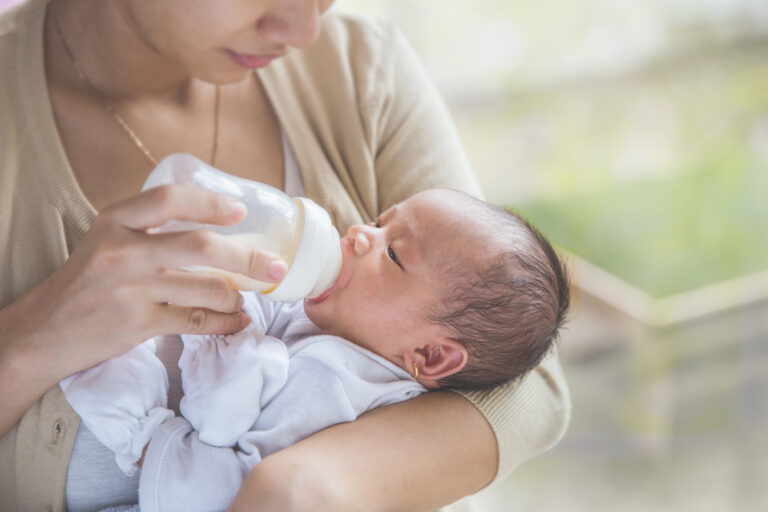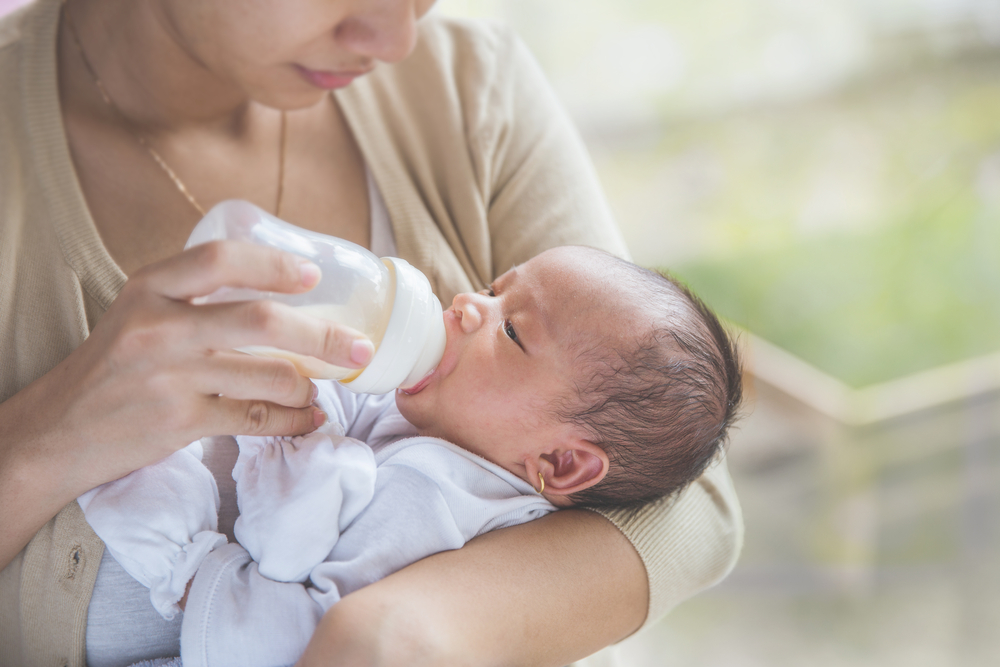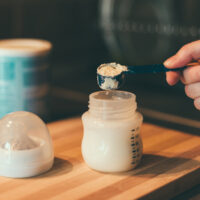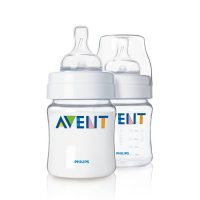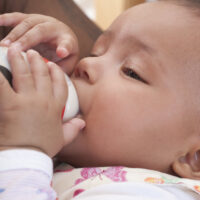Just when you and your infant have found a comfortable groove when it comes to feeding, suddenly something changes. Baby may start pushing away bottles. He or she may seem uncomfortable or frustrated when eating. Or it now takes forever for your little ones to finish their meal. What’s a mom to do?
Your infant might be signaling that it is time to increase the nipple size on his or her bottles. Most newborn bottles come with nipples labeled “slow flow.” And they do just what you’d expect – milk flows at a slower rate to accommodate baby’s still-developing digestive tract.
But as baby takes more milk at each meal, it might be necessary to increase the flow size to make feedings more comfortable.
We’ve researched what signs your baby will send you when it is time to level up in nipple size or if you’ve made the switch too early. Also included below are best practices for babies who are breastfed and formula-fed, as well as what’s recommended for exclusive pumping moms. Read on!
What Is Nipple Size on a Baby’s Bottle?
Bottle nipples come in a variety of different sizes, shapes, and flow speeds to match a baby’s eating preferences. Nipple sizes control how slowly or quickly milk flows from the bottle.
As mentioned, most bottles for newborns come with smaller nipple sizes. The ideal flow rate allows a few drops of milk to fall when the bottle is tipped upside down.
Each bottle manufacturer includes different nipple sizing and age recommendations on when to size up. But, it is important to note that age is not the only factor when it comes to switching bottle nipple sizes.
How Many Nipple Sizes Are There?
Some brands have three nipple sizes. Others have many more. Here are the general age guidelines that manufacturers follow:
- Slow flow: newborn to 3 months
- Medium flow: 3 months to 6 months
- Fast flow: 6 months to 12 months
You should always check with your baby’s specific bottle manufacturer since there is no set standard when it comes to bottle nipple sizing.
For example, Dr. Brown’s offers six different nipple sizes.
- Preemie Nipple for newborns 0 months+: This nipple is designed for premature babies and babies who have a slower feeding preference.
- Level 1 Nipple for newborns 0 months+: This nipple is a great starting point for many newborns. This size is included with most of Dr. Brown’s bottles and is designed to mimic the milk flow during breastfeeding.
- Level 2 Nipple for infants 3 months+: The company advises to consider increasing to a Level 2 if it is taking a longer time to feed from a Level 1 nipple, if baby is accepting early solid foods or if pediatricians have recommended thickening milk.
- Level 3 Nipple for infants 6 months+: This nipple is designed for babies who are sitting up, eating solid foods, or if their pediatrician has recommended thickening their milk.
- Level 4 Nipple for babies 9 months+: This nipple is appropriate for babies who have had no difficulties with bottle feeding and who are drinking larger amounts of milk at the breast and bottle. Level 4 is best for babies who are eating finger foods and drinking from a sippy cup.
- Y-Cut Nipple for babies 9 months+: The company advises to consider the Y-cut nipple if baby’s pediatrician has recommended thickening milk. This nipple accommodates thicker liquids and cereals.
Many manufacturers also offer nipples with an even slower flow for premature babies. For older babies who are drinking more milk at each feeding and who seem frustrated by even the fastest flow nipple, consider transitioning away from the bottle to a sippy cup or straw cup.
Many pediatricians recommend babies stop drinking from bottles by 12 months old to prevent cavities.
When Do You Know If It Is The Right Time To Switch Nipple Sizes?
The decision to switch nipple sizes is specific to each baby and not based simply on his or her age.
Some babies will never need to increase the nipple size on their bottles. Just because your baby is 4 months old, that does not necessarily mean it is time to level up to medium flow nipples if he or she is feeding well and seems content. Only consider a switch if baby suddenly seems irritated at feedings.
According to the American Academy of Pediatrics, the nipple hole may be too large if baby seems to be gagging or gulping milk too fast. On the flip side, if baby is sucking hard and seems frustrated, the nipple hole may be too small.
If your baby is showing any of these signs, it might be time to increase nipple flow.
- Taking longer to finish a feeding than what is normal for him or her (typically, this could mean feedings are taking 30 minutes to an hour)
- Becoming fussy or agitated when eating
- Falling asleep during feeding
- Eating less at feedings but becoming hungry shortly after
- Frequent latching and un-latching from the bottle during feeding
- Sucking hard
- Flattening or collapsing the nipple
- Smacking at the bottle
- Leaves milk in the bottle consistently for each feeding when he or she previously used to finish
- Getting visibly frustrated (crying, kicking, pushing the bottle away, squirming, etc.)
What Signs Will Baby Give When Nipple Sizes Are Increased Too Early?
If you’ve made the switch to a faster flow nipple, look out for these signs that baby is not quite ready. You can always switch back to a slower flow.
- Milk dripping from the mouth
- Gulping
- Coughing
- Choking
- Struggling to swallow between sucks
- Eating too quickly than what is normal for him or her (typically, this could mean feedings are taking 5 minutes-10 minutes)
- Refusing the bottle
Before changing the nipple size on the bottle, you should examine the condition of your existing bottle nipples. According to experts, frequent and repeated sterilization may distort nipple openings. That may be the cause for discomfort in your little one. To prevent this, test to make sure the milk flow is still adequate and doesn’t need replacing.
How Do You Make the Switch to a Larger Nipple Size?
You’ve determined that it is time to increase the nipple size on your baby’s bottles after observing signs of readiness and considering how much milk they are drinking at each feeding. Now what?
Experts recommend using the slowest flow that your baby will tolerate to prevent accidentally overfeeding. Also, increase the nipple size gradually. It is not a good idea to jump from the slowest flow to the fastest flow nipple, for example. That may be overwhelming for your baby.
When trying out an increased nipple size, continue paced feedings.
- Keep baby upright rather than lying flat during the feeding.
- Hold the bottle horizontally instead of tipping the bottle toward baby’s mouth. Milk should fill the tip but not the entire bowl of the nipple.
- Take short breaks between swallows. Occasionally, tip the bottle downward, so that milk is not flowing. This simulates the time between letdowns during breastfeeding.
Paced bottle feedings help little ones to learn the feeling of satiety and when they become full to prevent overeating.
Choosing the Right Nipple Size for Babies Who Feed from Breast and Bottle
Typically, babies who are primarily breastfed with an occasional bottle here and there should not need to level up in nipple size, according to the experts. This means using slow flow nipples throughout your breastfeeding journey will work great!
The reason behind this is because breasts are usually slower to release milk than a bottle nipple, so it is best to keep the bottle flow as close to nursing as possible. If a breastfed baby is given a faster flow nipple, he or she may begin refusing the breast and prefer the bottle. It is less work for them!
However, this does not apply to all breastfeeding moms and babies. Some breastfeeding moms have a fast letdown and quicker flow. If that is the case, babies may get frustrated with the slower flow nipple. Assess your flow and find what works best for your baby.
Regardless of nipple sizes, if planning on introducing bottles to exclusively breastfed babies, try to keep the feeding experience as similar to nursing as possible by changing positions and practicing paced bottle feedings. Your little one should have to work for milk in the bottle, just as he or she does at the breast. This will help prevent baby from favoring one method over the other, as well as overfeeding.
Set yourself up for success with the best bottles for breastfed babies.
Choosing the Right Nipple Size for Exclusively Pumping Moms
If your baby is getting breast milk through a bottle, it is still recommended to use the slowest flow nipple.
Breast milk is thinner than formula and babies tend to digest breastmilk more quickly. Since bottle feeding can often lead to inadvertently overfeeding, using slow flow nipples will help baby regulate their milk intake, especially when they are newborns.
Choosing the Right Nipple Size for Formula-Fed Babies
As with babies who drink breast milk, newborns who are fed infant formula should always start with the slowest flow nipple that manufacturers offer. This will help baby’s still developing digestive tract and keep little ones from overeating.
As infants get older and start to drink more milk at each feeding, you may find that increasing nipple size is necessary to keep feedings efficient. Typically, it should not take more than 30 minutes to an hour to finish a bottle. And remember, prepared formula must be thrown away at the one hour mark if not refrigerated.
When switching sizes, give baby ample time to adjust to the faster flow by feeding him or her upright. They don’t have to be at an uncomfortable 90-degree angle, but their head should be much higher than their bellies when eating.
Be sure milk is not dribbling out of baby’s mouth and that your little one’s swallowing is not labored. As with breastfed babies, paced bottle feedings are a great idea. During paced feedings, baby’s bottle is held horizontally and baby is given frequent breaks.
How Often Should I Be Replacing Nipples on Baby’s Bottle?
Regardless of whether you decide your baby is ready to switch to a larger nipple, you should replace existing nipples regularly.
Unlike bottles, which maintain their condition much longer, nipples see more wear and tear and rough use, especially from little ones who are teething.
A general rule of thumb is to toss old bottle nipples within three months, but always check the strength of nipples to be sure you don’t need to replace them sooner.
You should replace nipples if you notice tears, cracks, discoloration, or thinning. Tears and cracks are especially concerning because it can lead to milk coming out in a steady stream and pose a potential choking hazard.
To check the condition of your baby’s bottle nipples, pull on the bulb and be sure it returns to its original shape. Likewise, when you tip the bottle upside down, only a few droplets of milk should fall rather than a stream.
Final Word About Finding The Perfect Bottle Fit
If your baby is frustrated and uncomfortable during feedings and leveling up on bottle nipple sizes has not worked for your little one, there are other things to take into consideration.
Some manufacturers recommend experimenting with different bottle nipple shapes. Standard nipples are tall and dome-shaped. However, some manufacturers sell bottles that mimic the shape of the breast, such as the Comotomo Baby Bottles.
Other bottles come with orthodontic nipples that are wide at the tip and base and narrow in the middle. Some bottles have angled nipples as well.
Your baby might also have a preference for the material of nipples. They are made of either latex, which is softer but tends to wear out more quickly, or silicone, which is sturdier and easier to clean.
Each baby is unique and will have his or her own likes and dislikes. It is important to keep in mind, however, that the decision to increase nipple size will be baby-specific, not age-specific. Your little one will surely let you know if something needs to change.
